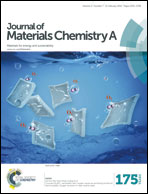Morphology and crystal phase evolution induced performance enhancement of MnO2 grown on reduced graphene oxide for lithium ion batteries†
Abstract
MnO2 nanorods grown on reduced graphene oxide (MnO2-NR/rGO) have been synthesized through a hydrothermal treatment of the reaction product between KMnO4 and 2-(N-morpholino)ethanesulfonic acid in the presence of graphene oxide. When tested as an anode in a lithium-ion battery (LIB), the obtained MnO2-NR/rGO exhibits a significant enhancement in electrochemical performance, especially after being discharged/charged for 300 cycles. Characterization of the microscopic features suggests that the morphology and crystal structure of the MnO2 nanorods evolve gradually during cycling, transforming the product of the MnO2-NR/rGO into a unique electrode architecture consisting of well-separated rGO coated with well-crystallized λ-MnO2 after 300 cycles. The significantly enhanced electrochemical performance of the MnO2-NR/rGO electrode after 300 cycles is attributed mainly to the resulting electrode architecture, which enhances the interaction between MnO2 and rGO, reduces the charge transfer resistance across the MnO2/rGO interface, and makes the rGO readily accessible to lithium ion storage. The demonstrated specific capacity and rate capability are among the best ever reported for transition metal oxide based electrodes for LIBs.



 Please wait while we load your content...
Please wait while we load your content...